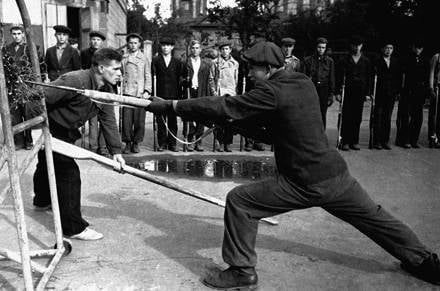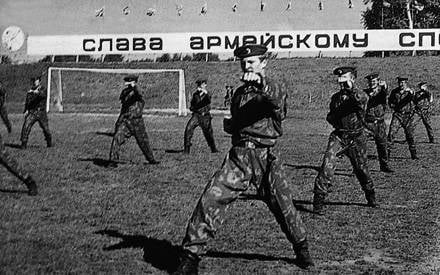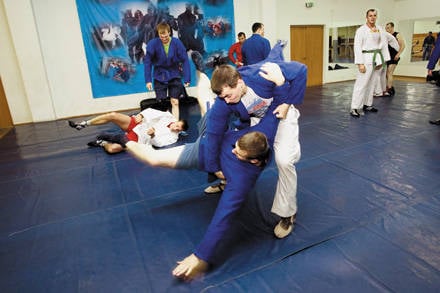Hand-to-hand fight. Soviet history

In 1919, a program of hand-to-hand fighting was published in the Red Army. In the same year, the "Guide to bayonet combat" was approved. In 1923, the first official manual on physical training was published, which was called “Physical training of the Workers 'and Peasants' Red Army and pre-draft youth”. It contained sections: “Possession of cold weapons"And" Ways to protect and attack without a weapon. " Since the old school of training was largely lost, its place was occupied by Western boxing, Greco-Roman wrestling and Oriental judo and Jujitsu. At the beginning of the 20-ies of the last century, sports sections are created in which they study methods of defense and attack without weapons, possession of cold arms.
16 April 1923 was established the Moscow proletarian sports society "Dinamo", in which the self-defense section worked under the leadership of Viktor Spiridonov. In 1928, he publishes the book Self-Defense Without Weapons, in which he synthesizes jiu-jitsu with the technique of French wrestling. In 1930 year, V.Oshepkov was invited to the department of defense and attack of the State Center for Basic and Pedagogical Education as a teacher of an optional judo course. The curriculum of the department included the study of the basics of sports training in classic wrestling, boxing, fencing, bayonet fighting and strength training. It was during these years that the shock and wrestling techniques were combined into a single complex of an applied nature.
In 1930, for operational officers of the GPU and the police N.N. Oznobishin was released guide "The Art of hand-to-hand combat." The author critically assessed and compared various martial arts known at the time. Based on personal experience N.N. Oznobishin developed the original combined system. It was the first attempt in the country to combine hand-to-hand, close fire fighting and psychological stresses of the fight into a single whole.
Spiridonov, for the first time in world practice, implemented a feedback system, when the VChK officers, after the criminal was detained, filled out special, “prepared in advance” questionnaires in which they indicated the methods and techniques used to detain the criminal.
It was not only the law enforcement agencies, but also the Red Army that had to apply their skills in practice.
Events on Lake Hassan and Khalkhin-Gol, as well as the Soviet-Finnish war, showed that massive use of hand-to-hand combat in a modern war is unlikely. This is a war of technology, engines and maneuver with fire defeat. The Finnish war also showed the need for comfortable warm clothing, the lack of which complicated even the exploration of the classic use of hand-to-hand combat. As a result, the Finnish War left very few examples of melee.
The outbreak of the Great Patriotic War pushed to the distant plan the development of the sports direction of hand-to-hand combat. In deployed battles applied hand-to-hand combat was used. These bouts are divided into two categories:
- massive contractions in general combat;
- fights in the conduct of intelligence raids, searches and ambushes.
The first category, although it showed mass heroism and cruelty of the war, did not require systemic behavior from hand-to-hand combat.
Professionally trained military intelligence officers and saboteurs. They were taught to plan bouts, to carry out them meaningfully, achieving the necessary goal.
There were selected fighters who know how to think, with good physical data. During the war, their training system was improved and well-adjusted. Here is a brief battle episode from the book of the naval intelligence officer twice Hero of the Soviet Union V. N. Leonov: “Barinov's platoon is the closest to the barrage. Tearing off his quilted jacket, Pavel Baryshev threw it on the barbed wire and crossed the fence. The tall Guznenkov jumped over the wire, fell, crawled away, and immediately opened fire on the doors of the barrack.
The scouts began pulling off their jackets, the cape, approaching the barbed wire. And Ivan Lysenko ran up to the iron cross, on which the wire hung, bent down, with a strong jerk, threw the cross onto his shoulders, slowly rose to his full height and, spreading his legs, shouted hysterically:
- Go ahead, chaps! Dive!
- Well done, Lysenko!
I slipped into the gap formed under the fence.
Overtaking me, to the barracks and cannons, to the dugouts and dugouts fled scouts.
Semyon Agafonov climbed onto the dugout roof, near the cannon. “Why is he this?” I wondered. From the dugout jumped two officers. The first Agafonov shot (later it turned out that it was the commander of the battery), and the second, the chief lieutenant, was stunned by the butt of the machine gun. Jumping, Agafonov caught up with Andrei Wheat, and they began to make their way to the cannon with grenades.
Agafonov and Pshenichnykh were still hand-to-hand fighting with weapons, while Guznenkov and two breeders, Kolosov and Ryabchinsky, were already turning the gun towards Liinhamari. ” The description of the fight shows a combination of close fire and hand-to-hand fighting.
To systematize and describe the experience started after the war. Thus, in the year 1945, KT Bulochko’s “Physical Training of a Scout” manual is published, in which the author, using military experience, describes the techniques and methods of hand-to-hand combat. And almost everything given in the book has not lost its relevance now.
The troops of the NKVD have manifested themselves in many ways. It is worth remembering the unit, called the troops of a special group of the NKVD. In 1941, the unit was renamed as a separate special purpose motorized rifle brigade. Many prominent athletes of the Soviet Union served in the brigade: arrows, boxers, fighters, etc. Thanks to their experience and skills, prisoners were captured, raided and ambushed in territories captured by the enemy. Moreover, a significant proportion of silent, only by hand-to-hand combat techniques.

In the war of the Land of the Rising Sun with the USSR, the Japanese did not even think to measure themselves in hand-to-hand combat with Soviet soldiers. If such fights took place, then our fighters would come out victorious. There is no mention of the practical benefits for the Japanese in these fights of martial arts.
According to the experience of past wars, the place of hand-to-hand combat in the training of a warrior was determined as a means of physical and psychological preparation. Hand-to-hand combat was used to develop motor skills and abilities, correct orientation in the conditions of close combat, to be able to fire the first shot, throw a grenade, strike with cold weapons, perform a move.
In the melee, the enemy was used primarily to defeat the enemy, and cold weapons and martial arts techniques were used only in a sudden encounter with the enemy, in the absence of ammunition or firearm failure, if necessary, destroy the enemy silently or in captivity. This prompted the fighters to instantly navigate in a rapidly changing environment, taking the initiative, to act decisively and boldly, using the acquired practical knowledge entirely.
In connection with changes in weapons, equipment, tactics, tasks and the doctrine of warfare, the attitude in the army towards hand-to-hand combat also changes. Thus, in the 1948 Physical Training Instructions of the Year, actions from improvised means and methods of attack and defense without weapons are excluded from the “Hand-to-hand Combat” section.
Since 1952, in the army, competitions in hand-to-hand combat have ceased. In the year 1967, the Soviet army stopped the cultivation of fencing classes on rifles with elastic bayonet. This is primarily due to the consequences of the military-technical revolution.
Despite the foregoing, the interest in self-defense techniques, fading somewhat in one place, was more pronounced in another. The development of hand-to-hand combat went from one phase to another, it was revived with a new force through the sambo system.
The events on Damansky Island, where the provocations of the Chinese were massive and regular, returned attention to hand-to-hand combat again. The Chinese sought to provoke the use of weapons by Soviet border guards. As a result, violent hand-to-hand fights ensued. Here is how the hero of the Soviet Union describes the first commander of Alpha, Major General Vitaly Bubenin, who commanded one of the frontier posts in this section of the border: “And so it began.” Thousands of selected, healthy, strong, furious fighters clashed in a deadly battle. A powerful wild roar, groans, screams, cries for help rang out far above the great Ussuri River. The crack of stakes, butts, skulls and bones complemented the picture of the battle. Many machine guns no longer had stocks. The soldiers, wrapping their belts in their hands, fought with what was left of them. And the loudspeakers continued to inspire the bandits. The orchestra did not stop for a minute. Another ice battle in Russia from the time of the battle of our ancestors with dog knights. " The book has many detailed descriptions of individual and group fights. The conflict ended with the application tanks and artillery, including Grad multiple launch rocket launchers, and combat losses on both sides. Nevertheless, it became clear to everyone that hand-to-hand combat still required study and development.
The country was entering a stagnant but relatively quiet time. The absence and unwillingness of change in society affected the development of hand-to-hand combat.
Nevertheless, since the end of the 60 of the last century, great interest in karate has appeared in the USSR. This kind of struggle was brought to our country by foreign students who studied at Soviet universities, employees of foreign firms, and Soviet specialists who worked abroad.
Karate was gradually legalized. Official structures struggle with it, then they give support.

Along with the development of karate clubs, schools and other martial arts appear: kung fu, taekwondo, Viet-Dao, aikido, jiu-jitsu, etc. The sports halls of many educational institutions were overwhelmed by those who wanted to master the "secret systems".
It was a time when Bruce Lee was filming his films that turned the world of martial arts around. And in the Soviet Union, they acted better than any party propaganda. Naturally, martial arts were associated with bourgeois ideology and developed slowly. But developed and processed in the understanding of the Russian mentality. So, A. Shturmin with T. Kasyanov “Russified” karate by transferring the eastern base to the Russian mentality. Later, Kasyanov went further, creating a sporting hand-to-hand fight with karate, boxing techniques, throws, trips, hooks and painful techniques. Moreover, hand-to-hand combat of this direction included sambo techniques, and Kasyanov considers himself a student of A. Kharlampiev.
In April, the All-Union Training and Certification Workshop for martial arts instructors was held at the CSKA base on the basis of CSKA. The workshop was attended by 1990 military instructors. An attempt was made to popularize among the servicemen and law enforcement officers a hand-to-hand fight modernized by Kasyanov. On the one hand, the instructors were not ready to accept the new requirements, on the other - the eastern base did not fit the army requirements, as a result of which there was no great success. AA Kadochnikov, who had his own view on hand-to-hand fighting, was also present at the seminar.
Kadochnikov was the first in the world to apply an engineering approach to the construction of hand-to-hand combat. Information about him as a Kuban nugget, reviving Russian combat systems, dates back to the middle of the 80-s of the last century. He worked at the Department of Theoretical Mechanics in the Krasnodar Rocket School, where he brought the scientific theory under the practice of various actions in hand-to-hand combat. He also succeeded in what T. Kasyanov unsuccessfully sought. The initiative group, which included Aleksey Alekseevich, receives an order to carry out research works from the Ministry of Defense. The practical base for practicing the methods is a non-staff intelligence company of the Krasnodar Rocket School, formed at the initiative of the same group of like-minded people. Subsequently, their initiative turned into the creation of a special forces training center according to the methods of the Russian combat system, which existed as a military unit until the 2002 year.
In the period from the beginning of the 90-s to the present, Kasyanov and Kadochnikov brought up many students who founded their directions in hand-to-hand fighting and martial arts. The students engaged with Kasyanov created the Budo club in 1992, while preserving and perfecting the ideas of martial arts with the Russian mentality. In 1996, the Alfa-Budo club appeared, which is closely associated with the Alfa Special Forces Veterans Association. This club, in preparing its students, synthesizes the Eastern principle, the Russian mentality and the spirit of the military fraternity of the Alpha special forces.
Many founders of modern Russian combat systems began and interacted with Kadochnikov. For example, the founder of the Russian self-defense system, ROSS, A. I. Retiunskikh, from 1980 to 1990, attended Kadochnikov’s classes for a year. The creators of the military BARS military system, S.A. Bogachev, S.V. Ivanov, A.Yu. Fedotov, and S.A.Ten, contacted VP Danilov and S. I. Sergienko, who worked with Kadochnikov, and for their systems borrowed many of the principles of the A.A. Kadochnikov school. Danilov and Sergienko, who served in the Krasnodar Special Forces Training Center, after leaving the reserve, established their own combat system. In this system, they adapted the experience of training special forces soldiers for self-defense actions in everyday life. This is how the COLLECTION - the Russian combat system.
Kasyanov, Kadochnikov, and many other founders of various types of martial arts in their publications and interviews often speak with regret about students who disagreed with them and began to develop their own schools and directions. To lament about this is a hopeless business, the modern information age makes knowledge generally accessible. Knowledge does not close in the bottle - will flow out. Knowledge is not a rival resource. Even using them as a commodity has a peculiarity: when moving to someone, they remain with the original carrier.
That is why, at the present stage, none of the existing systems will be accepted as the basis for training in law enforcement agencies of the country. The security agencies will use only the necessary of them, forming their own training system taking into account the tasks at hand.
- Vyacheslav DMITRIEV
- http://www.bratishka.ru"rel =" nofollow ">http://www.bratishka.ru
Information